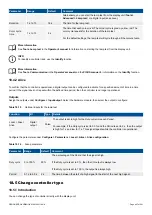
Example of how breaker priority works
Figure 17.1
Breaker priority example system
G
G
G
G
Emergency
load
Busbar A
Busbar B
BTB
GB2
SCB
SGB
GB1
GB3
TB
Genset 1
Genset 2
Genset 3
SHORE
connection
In the example diagram, it is assumed that the single line diagram in the controller was built by placing the components in the
diagram in the following order:
1. Genset 1
2. Shore connection
3. Bus tie breaker
4. Shaft generator
5. Genset 2
6. Emergency genset
This means that the breakers were assigned the values and priorities in the table below.
Table 17.3
Example breaker priority values assigned to each Modbus address
Component
Modbus address (Holding
register and input register)
Breaker priority: Buffered
value
Breaker priority: Value
Genset 1
14001
0
1
Shore connection
14002
0
0
Bus tie breaker
14003
0
0
Shaft generator
14004
0
0
Genset 2
14005
0
2
Emergency genset
14006
0
0
14007
0
0
The Modbus addresses are assigned to the breaker for the controller. This means an emergency genset always uses two Modbus
addresses for breaker priority, one for each breaker. The Modbus addresses are assigned to the components in the order that they
were inserted into the single line diagram. The Modbus address(es) assigned to a component will not change when the controller ID
changes.
Only genset breakers will be assigned a breaker priority value that is between 1 and 128. All other components and addresses
which are unassigned (for example 14008 in the example above) have a breaker priority value of 0. Both the breakers for an
emergency genset always have a breaker priority of 0. Breakers with a breaker priority of 0 assigned to them, cannot be changed.
DESIGNER'S HANDBOOK 4189340911K UK
Page 482 of 521
















































